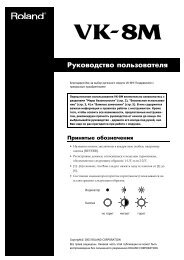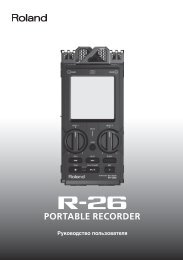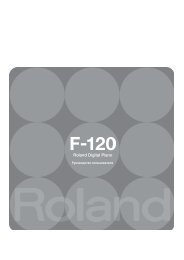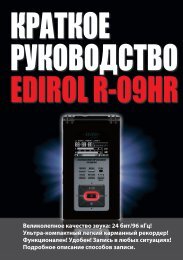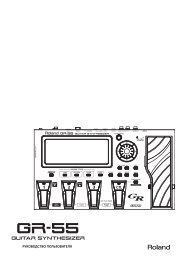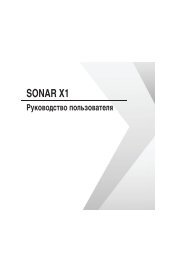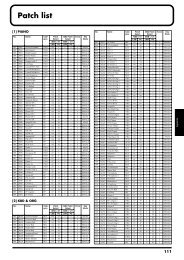Owner's Manual - Roland
Owner's Manual - Roland
Owner's Manual - Roland
- No tags were found...
Create successful ePaper yourself
Turn your PDF publications into a flip-book with our unique Google optimized e-Paper software.
About MIDIMIDI (Musical Instruments Digital Interface) is a standardspecification that allows musical data to be exchanged betweenelectronic musical instruments and computers. MIDI With a MIDIcable connecting MIDI devices that are equipped with MIDIconnectors, you can play multiple instruments with a singlekeyboard, have multiple MIDI instruments perform in ensemble,program the settings to change automatically to match theperformance as the song progresses, and more.If you mainly use the Fantom-X as a standalone keyboardinstrument, you may really not need to know much at all aboutMIDI.However, the following MIDI-related information is provided soyou can play the Fantom-X using an external MIDI device, or masterother advanced techniques.About MIDI ConnectorsThe Fantom-X is equipped with the three types of MIDI connectors,each which works differently.fig.33-003MIDI IN ConnectorThis connector receives MIDI messages that are transmitted fromexternal MIDI devices. The Fantom-X can receive these messages toplay notes or select sounds, etc.MIDI OUT ConnectorThis connector transmits MIDI messages to external MIDI devices.The Fantom-X’s MIDI OUT connector is used for sending theperformance data of the keyboard controller section as well as dataused for saving various settings and patterns.MIDI THRU ConnectorMIDI messages received at MIDI IN are re-transmitted withoutchange from this connector to an external MIDI device. Use this insituations such as when you use multiple MIDI devicessimultaneously.MIDI Channels and Multi-timbralSound GeneratorsMIDI transmits many types of data over a single MIDI cable. This ismade possible by the concept of MIDI channels. MIDI channelsallow messages intended for a given instrument to be distinguishedfrom messages intended for another instrument. In some ways,MIDI channels are similar to television channels. By changing thechannel on a television set, you can view the programs that are beingbroadcast by different stations. In the same way, MIDI also allows adevice to select the information intended for that device out of thevariety of information that is being transmitted to it.fig.33-004.eThe TV is set to the channel of the stationyou wish to watch.MIDI uses sixteen channels; 1 through 16. Set the receiving device sothat it will receive only the channel that it needs to receive.Example:Set the Fantom-X to send Channel 1 and Channel 2, then set soundmodule A to receive only Channel 1 and sound module B onlyChannel 2. With this setup, you can get an ensemble performance,with, for example, a guitar sound from sound module A and bassfrom sound module B.fig.33-005.eStation AStation BStation CThe cable from the antenna carries the TVsignals from many broadcast stations.MIDI OUT MIDI IN MIDI THRUTransmit channel: 1, 2SoundModuleAReceive channel: 1MIDI keyboardSoundReceive channel: 2 MIDI INModuleBWhen used as a sound module, the Fantom-X can receive on up tosixteen MIDI channels. Sound modules like the Fantom-X which canreceive multiple MIDI channels simultaneously to play differentsounds on each channel are called multi-timbral sound modules.General MIDIGeneral MIDI is a set of recommendations which seeks toprovide a way to go beyond the limitations of proprietarydesigns, and standardize the MIDI capabilities of soundgenerating devices. Sound generating devices and music filesthat meet the General MIDI standard bear the General MIDIlogo ( ). Music files bearing the General MIDI logo can beplayed back using any General MIDI sound generating unit toproduce essentially the same musical performance.General MIDI 2The upwardly compatible General MIDI 2 ( )recommendations pick up where the original General MIDI leftoff, offering enhanced expressive capabilities, and even greatercompatibility. Issues that were not covered by the originalGeneral MIDI recommendations, such as how sounds are to beedited, and how effects should be handled, have now beenprecisely defined. Moreover, the available sounds have beenexpanded. General MIDI 2 compliant sound generators arecapable of reliably playing back music files that carry either theGeneral MIDI or General MIDI 2 logo.In some cases, the conventional form of General MIDI, whichdoes not include the new enhancements, is referred to as“General MIDI 1” as a way of distinguishing it from GeneralMIDI 2.297



